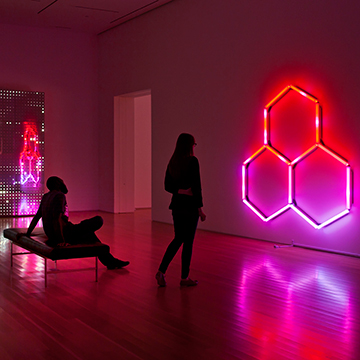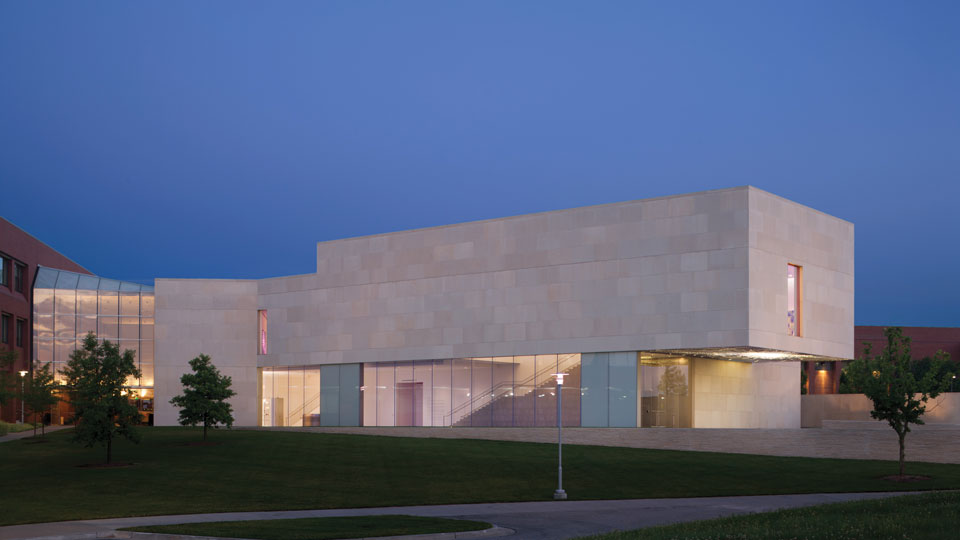Leo Villareal
Organized by the San Jose Museum of Art, and sponsored by the Andy Warhol Foundation for the Visual Arts, the Walter and Karla Goldschmidt Foundation, and Bank of America.
Microcosm, 2007 by Leo Villareal is a site specific permanent installation. It consists of thousands of white LEDs, custom software, electrical wiring and hardware. Collection of Nerman Museum of Contemporary Art.
The Nerman Museum of Contemporary Art presented the first-ever museum survey of the work of the prominent sculptor Leo Villareal, a pioneer in the use of LEDs and computer-driven imagery. Leo Villareal, organized by the San Jose Museum of Art, will feature approximately 20 sculptures and expansive installations by Villareal on loan from public and private collections, as well as video documentation of his architectural, site-specific works. The exhibition traces the artist’s work over the past decade, from his earliest experimental sequencing of strobe lights to his recent hypnotic patterning of thousands of pinpoint LEDs.
“Villareal so clearly understands the fundamental way that our visual experience and habits of perception have been influenced by technology, now so deeply integrated into contemporary life.” said Susan Krane, Oshman executive director of the San Jose Museum of Art. “He not only gives viewers the sensory thrill of his ever-changing displays of light: he also creates a participatory social space that is fascinatingly both relaxed and spectacular.”
The exhibition and publication are timely as Villareal’s reputation in the art world and his popularity reach new heights. In addition to his public commissions at the Nerman Museum of Contemporary Art and the National Gallery of Art, Washington, D.C., such institutions as The Museum of Modern Art, New York, and the newly reopened Tampa Museum of Art have recently acquired Villareal’s work for their permanent collections.
In 2006, Johnson County Community College commissioned a major, site-specific installation by Leo Villareal for the cantilever of the museum’s entrance. “The resulting piece, Microcosm, is now one of the museum’s most iconic works,” stated Bruce Hartman, executive director of the Nerman Museum of Contemporary Art. “Leo Villareal’s survey exhibition will be a dazzling and extraordinary experience for our entire community.”
“Villareal’s work is unique in that he bridges the subculture of technology and the broader international contemporary art world,” said JoAnne Northrup, the Drew and Katie Gibson Chief Curator at the San Jose Museum of Art who organized the exhibition and authored the main essay in the accompanying catalogue. “Why shouldn’t 21st-century artists use 21st-century technologies as creative tools? Although he relies on computers, his work is not about technology. Computers are necessary to drive the light sequences that compose his work, but he deliberately uses code that is simple and pared down. He focuses instead on the sequences, inspired by the mathematical formulae that form the basis of patterns found in nature.”
The works on view in Leo Villareal range in scale from the 36 in. x 30 in. x 7 in. sculpture Red Life (1999) to the 10 x 15-foot installation Diamond Sea (2007). Some works will be experienced in immersive installations. For example, Firmament (2001) consists of a 16-foot diameter, ceiling-mounted strobe light sculpture, sequenced by a microcontroller; visitors will recline on specially designed couches to experience the hypnotic animated patterns above.
“It is beauty that we experience with Villareal’s work, at times haunting and mysterious, at other times voluptuous and grand,” writes noted critic and scholar Michael Rush in his essay. “He offers a seriousness that may be digitally derived but is in no way virtual.”
The exhibition seeks to place Villareal’s body of work within the continuum of modern and contemporary art, from minimalism to the present. At the same time, it explores Villareal’s new vision for an art that responds and relates to the innovations of the 21st-century by using computer code and new technology as a medium for abstraction. “The essence of the piece is the code; colored light is the manifestation,” Villareal has said.
Born in Albuquerque, NM, in 1967, Leo Villareal was raised in El Paso, TX, and in northern Mexico. He began his studies in stage design and art at Yale University, New Haven, CT, and later pursued graduate studies at the Interactive Telecommunications Program at New York University’s Tisch School of the Arts, NY. From 1994 to 1997, Villareal worked on cutting-edge virtual reality projects at Paul Allen’s Interval Research Corporation in Palo Alto, California. In 1994, Villareal first attended the counterculture festival Burning Man, which inspired him to begin creating immersive experiences on a larger scale. In 1997, he programmed a 16-light strobe structure that he brought to Burning Man. Originally conceived as a nighttime wayfinding device using pulsing light, the simple light piece was well received and became the precursor to his work in the light medium. His recent major commissions include Sky (Tampa) (2010) at the Tampa Museum of Art, FL, Stars (2009) at the Galería Javier López in Madrid, and Multiverse (2008) at the National Gallery of Art, Washington, D.C. His work is in the collections of The Museum of Modern Art, New York, the Albright Knox Art Gallery, Buffalo, NY, the Nerman Museum of Contemporary Art, Overland Park, KS, the Naoshima Contemporary Art Museum in Kagawa, Japan, as well as other public and private collections.





